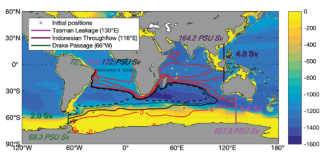Routes of the upper limb of the Atlantic Meridional Overturning Circulation
The meridional overturning circulation (MOC) of the Ocean is a key component of Earth's climate system. In the Atlantic sector, the MOC transports heat northward in both hemispheres, mitigating the temperature difference between the equator and pole in the North Atlantic, while amplifying the pole-to-equator temperature difference in the South Atlantic. In a recent article published in Geophysical Research Letters, researchers investigate the origins of the upper limb of the Atlantic Meridional Overturning Circulation (AMOC) (i.e. the return flow of the MOC into the Atlantic Ocean).

Visualization of the mass transport carried by particle trajectories (contours): red contours are 4 Sv apart; the black solid contour is -1 Sv, the black dotted contour is -1.5 Sv and the black dashed contour is -1.75 Sv. The color shading shows the depth (in meters) of the time-averaged potential density referred to 2000 decibars, σ2=36.6 kg/m3. The depth of this density surface outlines the flow-lines of the supergyre of the Southern Hemisphere. The section at 6°S is marked by black × and its transport is 13.6 Sv. The sections of origin are: at Drake Passage (66°W green); at Tasman Leakage (130°E magenta); at Indonesian Throughflow (116°E dark purple). The mass (in Sv) and salinity transports (in practical salinity units Sv) at each section are marked in the corresponding color (click image to enlarge).
To estimate the origin of the upper branch of the AMOC at 6°S, from different sections in the global ocean, the authors determine Lagrangian trajectories by tracing particles backward in time for 2,011 years. The velocity moving the particles is an estimate, called “Estimating the Circulation and Climate of the Ocean” (ECCOv4), combining over one billion observations with a global ocean model that conserves mass, momentum, temperature, salinity, and sea-ice over a regular grid.
Each particle carries a small amount of mass transport, which is conserved following the trajectory. Of the 13.6 Sverdrups (1 Sv = 106 m3/s) entering the North Atlantic across 6°S, 97% come from the tip of South Africa (Agulhas region) as a relatively warm and salty water mass moving westward and northward (known as the “warm route”). The remaining 3% enters from the tip of South America (Drake Passage) as a cold and fresh water mass moving eastward and northward (known as “the cold route”).
Going further from the Atlantic, the upper branch of the MOC receives its transport primarily from the region south of Australia (Tasman Leakage, 49%), followed by a close second contribution from the straits between Asia and Australia (Indonesian Throughflow, 35%), and a distant third contribution from Drake Passage (15%) (red and black contours in Figure 1). One of the key results is that all the routes follow the outer edges of the supergyre of the Southern Hemisphere and converge into the Agulhas region (the flow of the supergyre is outlined in the color-shading in Figure 1). Because of this subtropical origin, the water entering the Atlantic is relatively warm and salty, and gets further heated and salinified in the Atlantic.
The salty water entering the Atlantic gets further salinified by the excess evaporation in the basin, contributing to the densification necessary for convection in the North Atlantic, associated with the maintenance of the AMOC.
Routes of the Upper Branch of the Atlantic Meridional Overturning Circulation according to an Ocean State Estimate (Geophysical Research Letters)
